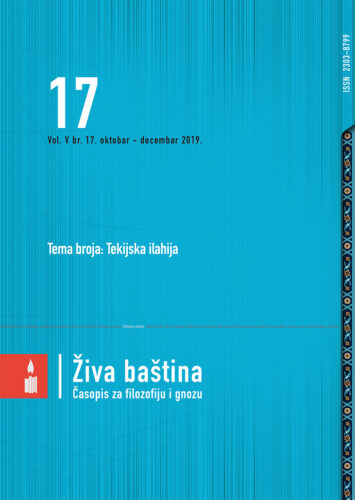UDK 783:28-29
Sakralna muzička tradicija Bošnjaka u cjelosti je realizirana u mekamatu – muzičkom sistemu orijentalno-islamskog kulturnog kruga. U mekamatu se uče Kur'an, salavati, zikrovi, salle i ezani. Posebno mjesto u toj sakralnoj muzičkoj tradiciji zauzimaju ilahije i kaside, a među njima tekijska ilahija kao autentični izraz bošnjačke duhovnosti i pjesničkog genija. Poput ezana na bosanskim džamijama, ilahije i kaside što se uče u našoj tradiciji bez izuzetka su realizirane u jednom od osam temeljnih mekama: saba, nehavend, adžem, bejati, sika, hidžaz, rest i kurd. Sama tekijska ilahija uglavnom je komponovana u mekamima bejati, nehavend i hidžaz, uz tek nekoliko izuzetaka. Autor ustvrđuje da je bosanska tradicija tekijske ilahije muzički oblikovala posebnu podvrstu mekama bejati, u ovom radu nazvanom „bosnejni“. U „bosnejniju“ je drugi ton na oktavi mekama bejati izravnavnan u temperovani sistem skala, tonski identičan dorskom modusu iz starocrkvenog muzičkog sistema. U isto vrijeme je „bosnejni“ očuvao melodijsko kretanje (sejir) mekama bejati, što ovu skalu nesmnjivo svrstava u sistem mekamata. U „otkrivanju“ nove podvrste mekama bejati, te ukazivanju na utjecaj tekijskih ilahija na savremene ilahije i kaside na bosanskom jeziku, poseban je značaj ovog rada. Također, njegov se značaj ogleda i u činjenici da se radi o prvom radu pisanom na južnoslavenskom govornom području koji se bavi mekamatom u tekijskoj ilahiji.
Music Maqams in Tekke Nasheeds
Extract
Sacral music tradition of Bosniaks is completely realised in maqamat – music system of Oriental-Islamic cultural circle. Qur'an, salawat, dhikr, salla and adhan are recited in maqamat. Nasheed and qasida take special place in that sacral music tradition, and amongst them tekke nasheed as authentic expression of Bosniak spirituality and poetic genius. Alike adhan that is recited in Bosnian mosques, nasheeds and qasidas that are recited in our tradition are, without an exception, realised in one of the eight main maqams: Saba, Nahawand, Ajam, Bayat, Segah, Hijaz, Rast and Qurd. The very tekke nasheed is most frequently composed in Bayat, Nahawand and Hijaz maqams, with only several exceptions. The author finds that the Bosnian tradition of tekke nasheed has shaped, in music terms, the special sub-category of Bayat maqam, in this paper referred to as “Bosnayni”. The second tone on octave in “Bosnayni” maqam is equalled in tempered system of scale, in terms of tone identical to dorian mode from medieval church music system. At the same time “Bosnayni” has preserved melodic movement (sejir) of Bayat maqam which, without doubt, places this scale into the maqamat system. This paper is especially important because it „reveals“ new sub-category of Bayat maqam, and it points to influence of tekke nasheeds on contemporary nasheeds and qasidas in Bosnian language. Also, this paper is significant due to the fact that this is the first paper written in Southern-Slavic language area that deals with maqamat in tekke nasheed.
Key words: tekke nasheed, tasawuf, maqam, maqamat, music, Bosniak culture, Bayat, Nahawand, Hijay, Ashik Junuz, Abdulvehab Ilhamija, Abdurrahman Sirrija, Muhammed Mejli, Selim Sami.
[tags]

